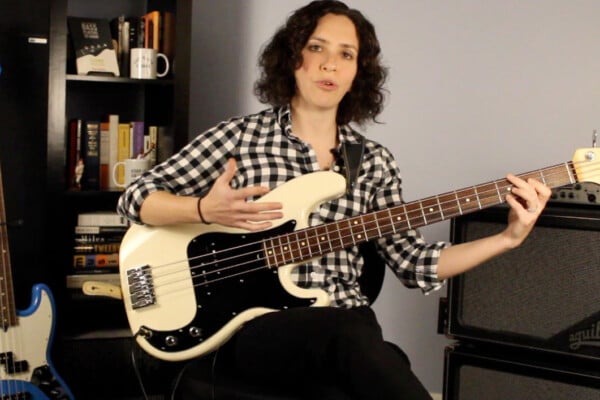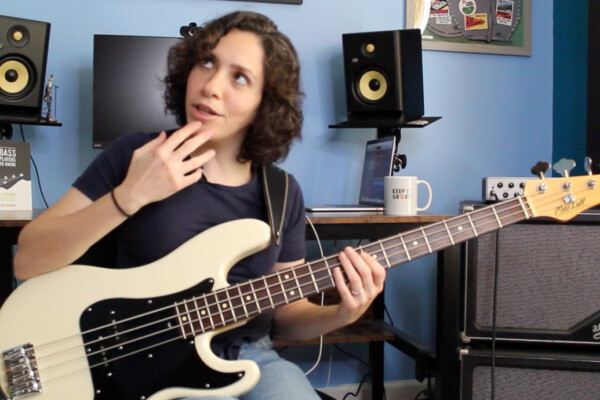Talking Technique: The One-Finger-Per-Fret Controversy
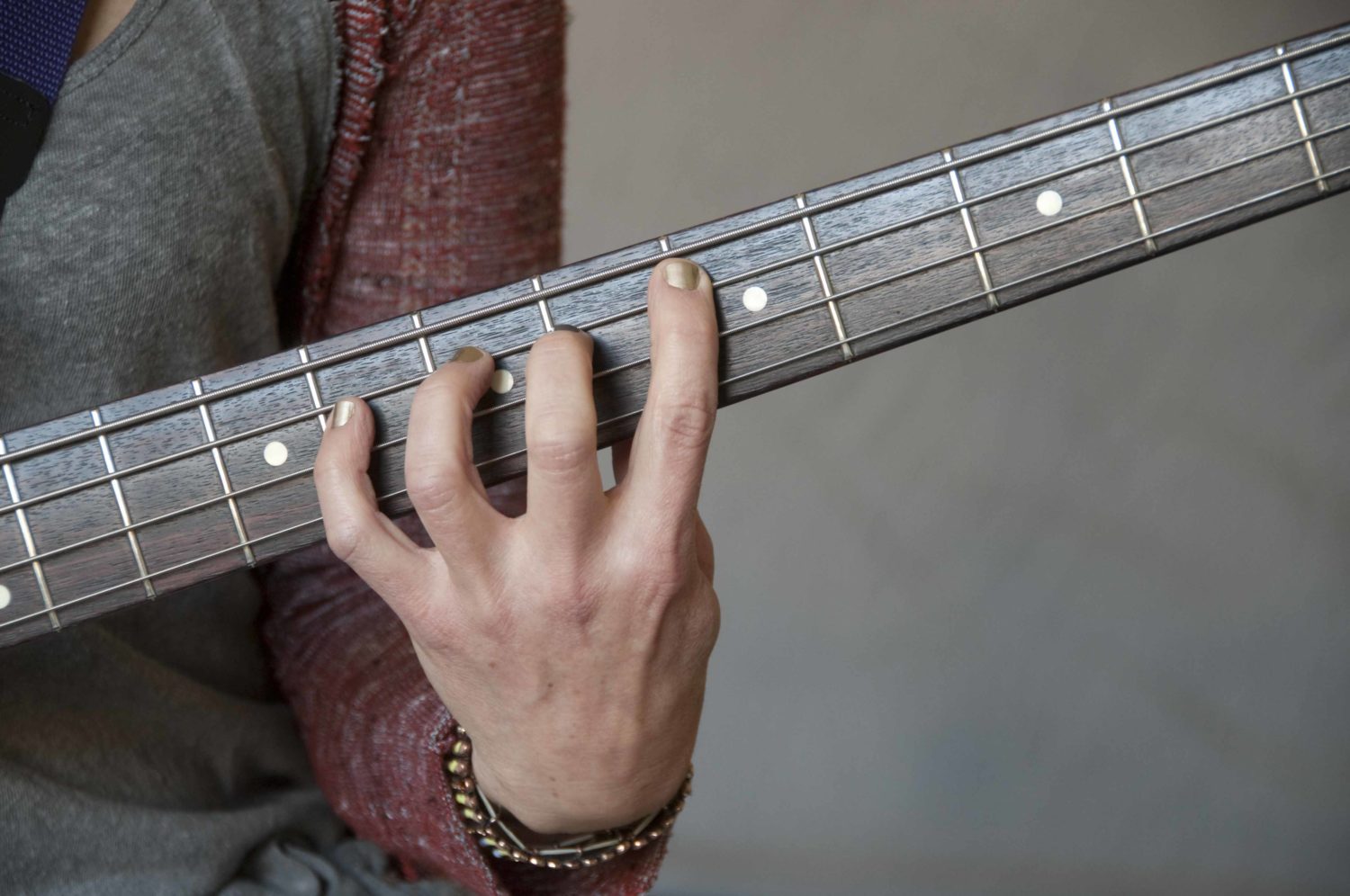
Some people are afraid for their fingers, while others swear by it: the one-finger-per-fret position. Is there is a reason to fret “one-finger-per-fret”? Not if done right.
Is it worth getting it down? Yes! [Read to the end for “Practice-with-me” videos.]
I definitely recommend having a solid grip (so to speak) on the one-finger-per-fret method. Practicing this way has numerous advantages, and, if done correctly, absolutely no disadvantages.
What is the one-finger-per-fret position?
As the name implies, we are positioning our fingers such that each finger has a fret assigned. We span a minor third on one string between the first and fourth fingers and we use second and third fingers on their assigned frets as well.
I see a lot of self taught players not use this set up and my theory is it is because it is more intuitive to start everything with the first finger when we are first starting out.That pointer finger is stronger because we use it more in daily life. We can “get by” doing pentatonic shapes (I call them “little boxes”, ie spans of a whole step) in such a way that we don’t need to span four frets, or we restrict the tonal material to roots and fifths, which also works for a while. Many players only use three fingers to fret, thinking the pinky is inherently too weak or they struggle fanning the hand open in the lower registers. The individual fingers are too weak to operate, instead the stronger muscles of the hand take over. What follows is collapsing the hand and over-gripping the neck. It sometimes looks like in this photo, with the palm pressed against the bass neck, also referred to as “The Pistol Grip” (photo at right showing collapsed fingers):
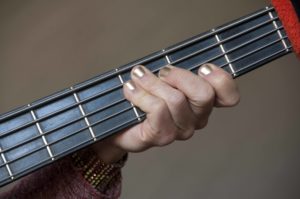 In my mind, what goes with the one-finger-per-fret position as a blueprint is much more than just having those fingers readily available and fit. Good left hand positioning means opening up the hand and having a relaxed thumb and overall balanced posture where the weight of the right arm on the bass body helps the left hand fingers fret.
In my mind, what goes with the one-finger-per-fret position as a blueprint is much more than just having those fingers readily available and fit. Good left hand positioning means opening up the hand and having a relaxed thumb and overall balanced posture where the weight of the right arm on the bass body helps the left hand fingers fret.
Advantages:
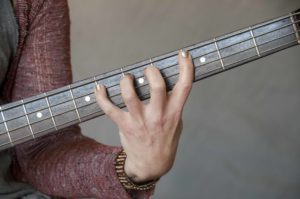
Economy of motion.
We have four fretting fingers, they can conveniently (if you don’t find that easy or convenient at first, read on!) reach the span of four frets. Why not use them? Fact is, using one-finger-per-fret we can:
- Move much faster
- Minimize shifting noises
- Optimize timing
When committing each finger to its home base, ie, fret, we have to move less and hence have more room for speed and accuracy. A great way to shed one-finger-per-fret involves permutation exercises for fitness and independence as demonstrated here.
A blueprint for music theory shapes and good fingering.
Music theory is a lot about shapes. As we practice those scales, arpeggios, intervals… we form strong kinesthetic memory in our fingers. We train our muscle memory through repetition while gaining understanding of what we are doing. Fingering these shapes in a consistent, one-finger-per-fret fashion is a logical and effective way to commit these shapes to memory all over the fretboard. Why reinvent the wheel each time you play a triad? Why stumble each time you play a pentatonic shape? It makes much more sense to commit these common shapes to muscle memory.
Understanding the bass fretboard.
The bass is tuned in fourths. A typical seven-note scale will have three (sometimes two) notes per string, being covered perfectly by four frets, ie, four fingers. One-finger-per-fret is the most effective and ergonomic way to make playing western music based mostly on seven note scales effective and fast. If we’d have music based mostly on the chromatic scale (which we don’t, even 12 tone music is not), I’d advocate a different tuning (major thirds?) to allow for one-finger-per-fret. Even the fifth tuning of the cello can’t compete. Only on violin or mandolin can the effectiveness be matched, because the hand can easily reach the equivalent of five frets on these smaller instruments, which again makes running a scale in one position possible and effective.
Certain scale shapes, such as when playing a dorian scale with the starting note on the lowest string, also create a five-fret span, however, with thought-out fingering using the whole step as a pivot point to move from one position to the next, you make shifting by a half step very accessible. I call that particular movement “the crab” because the hand moves sideways, like a crab.
If you organize the fretboard in four to five fret spans, sight reading and reading in general is also much easier.
A great starting point to expand from:
Some situations certainly are better served with alternate approaches. That said, one-finger-per-fret is the best starting point I know of. Practice it and it won’t stand in the way to doing something else where doing something else makes sense. Here are a few applications of alternatives to one-finger-per-fret:
- Using three notes per string to form patterns of the major scale (and its modes) hence spanning five frets so that the hand covers two whole steps. This is very effective for runs involving hammer-ons or pull-offs or speed licks for tapping.
- Playing a repetitive groove that only spans two frets – here it is entirely permissible to make the hand smaller.
- Some repetitive grooves in the lower register can be a strain. It is nice to shift the hand and do something different to tax different muscles for a while to switch things up.
- Grooves involving shifts between strings on the same fret (fourths and sevenths) are sometimes easier when alternate fingerings are used. In such cases one-finger-per-fret can mean wild string-crossing acrobatics and alternatives are in order.
- If you have any particular sound reason to not “one-finger-per-fret” it, then go for it. Rocco Prestia for example plays with only one and the same finger at times in order to mute the strings with the other three fingers for that thick Oakland funk. If there is a sound reason or special application why doing something a certain way would make sense, by all means, go for it!
Once one is well trained in this method, switching to other approaches on the fly is easy. Pro players frequently switch between various approaches very quickly and smoothly.
Also great for the Upright
When I dove into the study of Simandl, Streicher, Drew, and Montag, I already had a solid understanding of where the notes are on the electric bass fretboard due to using a one-finger-per-fret approach consistently when practicing scales and arpeggios. It was very easy for me to adapt to upright fingering using that same four-fret grid for orientation that I had in my mind’s eye from the electric. The shapes still unfolded in four-fret spans, even though the fingers had to shift a bit more on the upright neck because of using classical upright fingering. The organization and note finding, however, are of course the same and it was easy to translate and adapt my knowledge. ?Paradoxically, one argument often heard against one-finger-per-fret is the traditional upright fingering. Upright bass fingering, however, is not a valid model for electric bass, because:
- The ergonomics towards the bass neck are entirely different.
- The “frets” are much further apart, distances are much larger on upright.
- The physics of the instruments are entirely different.
- The force needed to press down a string properly on the electric is much less than on the upright. Even the pinky easily has enough strength to do this on its own. Tempos of scale runs (and similar figures) are severely limited (or much harder to execute) when using upright fingering.
- Upright fingering does not use the ring finger in lower positions (only as support for the pinky) – there is no reason to do the same on electric. The finger is strong enough and can stretch easily for the first finger to reach two frets higher (if you got really exceptionally small hands, make a small shift – still better than upright fingering)!
Struggling?
The struggle is often misunderstood as one of missing strength or small finger size. Rather, our hands are naturally used to gripping things, picking up objects with all fingers working in tandem. Give your hand (and mind!) time to find the smaller muscles that move each finger individually. Give your tendons time to adjust to their very specific job here. This is not a crude movement, it is what we call in German “Feinmotorik” – fine motor skills.
When you first give the one-finger-per-fret workout a try it may feel uncomfortable, strenuous, tiring. This is transitory and the best way to deal with transitioning is by using the PORA method.
Common problems and remedies:
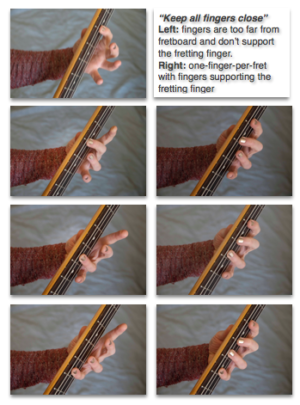 In lower registers you might struggle spanning the entire four frets. Find some help here. In short, instead of trying to span the entire four frets, make small movements up and down the neck to accommodate for the bigger distance. In the beginning, do technique exercises higher up on the neck and slowly expand to the lower registers.
In lower registers you might struggle spanning the entire four frets. Find some help here. In short, instead of trying to span the entire four frets, make small movements up and down the neck to accommodate for the bigger distance. In the beginning, do technique exercises higher up on the neck and slowly expand to the lower registers.
Keep all fingers close (see photo series).
Avoid lifting the fingers too far from the strings and think of fingers to the left of the fretting finger as support. What I mean by that is, if you are fingering 1 2 3 4, add each finger, rather than going through the trouble of lifting each finger. The left column in the photos is the Don’t. The right column is the Do. Soundwise, of course, it makes no difference if you are fingering the pinky but are stretching 1, 2 and 3 away from the strings or add them to the fretboard. In the dynamics of your hand, however, stretching those fingers away from the strings creates tension and effort in the hand. When fingering 1-4 for example ( a minor third on the same string), just add 2, 3 and 4 in one movement when going up that minor third. (see photos)
No tension. Relax.
If you get pain or discomfort using one-finger-per-fret, especially in the lower registers, scan for tension. Your hand is not too small, but likely you are working against yourself by doing any of the following:
- Squeezing the neck
- Using the thumb of your fretting hand to counteract the fretting force (use the right arm resting on the bass body instead!)
- Positioning the thumb at an angle that does not support the fretting fingers (is it sticking out above the neck?)
- Pulling up the left shoulder and thereby contributing to tension in the fingers
- Having a strap length that goes against your body’s ergonomics
- Pulling the elbow back and under the bass neck not giving the fingers enough room. Play with that movement, find the angle that is right for you, it fixes most issues I see with this method.
Never stretch the fingers forcefully.
It is not the size of your hand! Brutally pulling it into submission won’t do it. Don’t stretch or shake vigorously. Rather, when you get tired, let your hand drop and relax it, allowing the blood to return into the finger tips. Take a break. Come back to it. You are adjusting. Give it a minute!
The above, paired with patience and persistence (use PORA!) gets almost everyone I have ever worked with to be comfortable with one-finger-per-fret after a while. I have had the occasional student who had challenges with uneven fingers or a past injury that required unusual measures. You work with what you have, so we got creative and found work arounds! The above principles, (relaxation, not over-gripping etc), are universally healthy and are designed to be adapted to each person individually. The assignment here is not to “hold the hand at a 47.5 degree angle” – we are all put together differently, so that makes no sense. The assignment, however, is to feel into the hands, arms, fingers, to find the tension and release it, to release the thumb from over-gripping, to use the entire body to make fretting easier. It takes time and a bit of patience. Then, one-finger-per-fret becomes a natural and comfortable habit.
The Takeaways:
The one-finger-per-fret method of fingering is the most effective approach for most applications. There are exceptions as noted. But if you want to approach playing the bass systematically, make reading easier, sound more even, play faster, have a solid framework for good fingering, or if there is anything you are unable to do for technique reasons, then I recommend one-finger-per-fret as the best framework to expand from. It creates fretboard knowledge, lends itself for all important theory shapes and makes for maximum finger mobility and independence.
Want two technique exercises helping with one-finger-per-fret emailed to you? Access these exercises here.
Austrian-gone-Californian Ariane Cap is a bassist, educator, blogger and author. In her book Music Theory for the Bass Player and corresponding 20-week online course, she teaches music theory, bass technique, bass line creation and fretboard fitness in a systematic, practical and experiential way. She just released a brand new course on ear training for the bass player: Ear Confidence - 6 Paths to Fearless Ears. Contact her via her blog or website.


